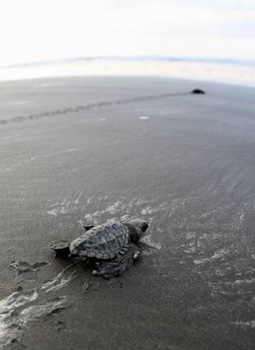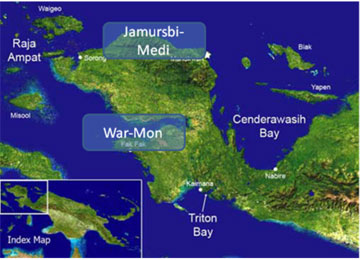“Turtle carbon” could help protect rainforests and save endangered sea turtles
“Turtle carbon” could help protect rainforests and save endangered sea turtles
Rhett A. Butler, mongabay.com
August 12, 2008
|
|
Using carbon credits to promote rainforest conservation could help protect endangered sea turtles in some parts of the world, argues a carbon finance expert.
Gabriel Thoumi, director of forestry at MGM International, says that “turtle carbon” could serve as a model for financing wildlife conservation through the emerging “payments for ecosystem services” schemes.
Thoumi’s premise is based on recent research showing that sea turtles are can be adversely affected by logging. The study, published earlier this year in the journal Oryx by scientists from the Smithsonian Tropical Research Institute and the Wildlife Conservation Society, revealed that logs wash up on important nesting beaches, impeding turtle reproductive success and even killing adult turtles. The logs caused multiple problems for sea turtles, including trapping and disorienting turtles, causing them to die; physically blocking access to nesting areas, forcing turtles to abandon nesting altogether or establish nests dangerously close to the waterline (seawater inundation kills sea turtle eggs); altering the structure of the beach so that turtles were unable to climb steps caused by sand erosion; and impeding the path of hatchlings to the ocean and increasing their vulnerability to predators.
 Hatchling Olive ridley sea turtle headed out to sea. Photo by Rhett A. Butler. |
Thoumi believes that reducing logging in critical areas can help diminish the number of logs that wash up on beaches, therefore helping turtles.
Thoumi specifically looks at War-Mon and Jamursba-Medi in Papua, on the island of New Guinea. According to the Bellagio Blueprint for Action, a proposal for protecting sea turtles, War-Mon and Jamursba-Medi are two of Indonesia’s ten most important nesting beaches for leatherback turtles.
Thoumi proposes using carbon credits generated from forest protection under the “Reducing Emissions from Deforestation and Degradation” (REDD) mechanism as a way to fund turtle conservation while simultaneously reducing the incidence of logs washing up on sensitive beaches. He says that funds generated by the so-called “avoided deforestation” scheme could go towards community development initiatives that protect turtles.
“By protecting Pacific Leatherback Turtle nesting habitats from logging, local communities can increase their income while preserving their native landscapes ability to provide clean water, healthy food, and shelter,” Thoumi told mongabay.com. “In this manner, local communities can directly be involved in local global warming mitigation activities at the same time as they increase their earning potential by developing sustainable.”
To take the idea beyond the conceptual stage, Thoumi says the project developer would need to better understand the specific threats to leatherback sea turtles by working with scientists.
“The developer needs to understand predation of eggs by rodents, dogs, and pigs and how sand temperature can effect turtle sex,” he says.
 Map of Jamursbi-Medi and War-Mon Beaches, Papua, Indonesia, adapted from Conservation International. Accessed 30 June, 2008. |
The developer would then need to discuss how to work with the local community to create “sustainability based” jobs including turtle protection and hatchling assistance jobs.
“The developer would provide funding for the locals to be hired to protect their beaches from drift logs and other fauna threats to the leatherback turtle nesting sites,” Thoumi explains. “This funding would allow the locals to develop and diversify their businesses. The funding source would be forward sales of avoided deforestation carbon markets credits secured by securing the source of the logged trees on the beach.”
“In other words, by securing the concession where the cut logs are originating, and using this concession as an avoided deforestation project, the developer can fund the protection of the leatherback turtles.”
The developer would then need to work with the local government to secure rights to protecting the logging concessions near the beaches.
Once the project is established, the developer could sell these “turtle carbon” credits into the voluntary carbon market, perhaps commanding a premium from firms interested in offsetting their emissions with “wildlife-friendly” credits.
William F. Laurance, lead author of the Oryx study, says the credits could be a compelling way to attract interest in avoided deforestation credits.
“It’s an intriguing idea,” Laurance told mongabay.com. “I think the link to a charismatic animal like the leatherback would help to attract investors in carbon credits… although it would be important to demonstrate that local logging is the source of logs blocking the turtle-nesting beaches.”